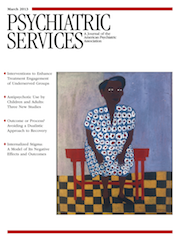Prescription of Second-Generation Antipsychotics: Responding to Treatment Risk in Real-World Practice
Abstract
Objective
This study sought to determine the extent of providers’ sensitivity to the presence of cardiometabolic disorders in the selection of second-generation antipsychotics.
Methods
As part of an academic detailing effort conducted between October 2007 and May 2009, all psychiatric providers at a single Veterans Affairs medical center completed a survey for every new prescription of an on-patent second-generation antipsychotic. The survey documented the drug prescribed, patients’ sociodemographic data, psychiatric and comorbid diagnoses, and reasons for the prescription. The association between obesity, hypertension, hyperlipidemia, diabetes, and cardiovascular disease and the choice of antipsychotics with varying levels of cardiometabolic risk was evaluated.
Results
Data consisted of 2,613 surveys completed by 259 providers. Olanzapine, with high cardiometabolic risk, and quetiapine and risperidone, with moderate risk, accounted for 79% of prescriptions. There was a significant (p<.001) association between the second-generation antipsychotic prescribed and obesity, hyperlipidemia, and diabetes but not hypertension or cardiovascular disease. The proportion of patients receiving olanzapine was only slightly smaller, by an average of 4 percentage points, among patients with cardiometabolic disorders than among patients without cardiometabolic disorders. The proportion of patients receiving aripiprazole, with little or no cardiometabolic risk, was consistently higher, by an average of only 2 percentage points, among patients with a cardiometabolic disorder versus without one.
Conclusions
Although this study found a statistically significant sensitivity by providers to cardiometabolic risk, this sensitivity was neither robust nor uniformly statistically significant. More research into how providers use medication risk information when making treatment decisions may help improve the quality of care.



